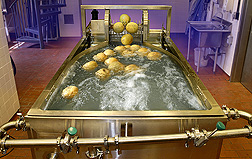This page has been archived and is being provided for reference purposes only. The page is no longer being updated, and therefore, links on the page may be invalid.
| Read the magazine story to find out more. |
|
Pathogen Studies Could Result in Safer Produce
By Jim CoreDecember 12, 2005
Because conventional washing methods to remove microbial contaminants from fresh fruit and vegetable produce surfaces have been found to be only marginally effective, Agricultural Research Service (ARS) scientists in Wyndmoor, Pa., want to give the produce packing and processing industries better techniques.
Bassam A. Annous, a microbiologist at the ARS Eastern Regional Research Center, Food Safety Intervention Technologies Research Unit, in Wyndmoor, and his colleagues are developing new technologies to remove or inactivate pathogens on both fresh and minimally processed produce.
Bacteria can quickly attach to the produce surfaces and form what are called biofilms that likely improve their ability to colonize and survive. A biofilm is a mass of microbes attached to a surface and to each other by bacterial polymers (complex sugars). This polymer coating may protect bacterial cells from exposure to antimicrobial compounds, such as chlorine, used to sanitize produce.
The human pathogen Salmonella is often responsible for produce-related outbreaks of foodborne illness. For example, Salmonella is difficult to remove from cantaloupe surfaces, because it attaches to inaccessible sites and forms biofilm on the cantaloupe rind surface. This allows the pathogen to avoid contact with the sanitizing solution. Surviving Salmonella cells can then be transferred from the surface of the melon into the internal tissues during cutting prior to consumption.
Annous and his colleagues recently gained new insight into biofilm formation by Salmonella on various surfaces. The ability of Salmonella cells to form biofilm on plastic or stainless steel surfaces was dependent on the production of fimbriae (hairlike structures) and cellulose that help the cells attach to and colonize surfaces.
Biofilm formation by Salmonella cells starts by attaching to the rind of cantaloupe following contamination. Once attached to the rind, Salmonella cells rapidly develop biofilm by growing and excreting polymers.This new knowledge helps explain how Salmonella survives harsh sanitizing environments.
Read more about the research in the December 2005 issue of Agricultural Research magazine.
ARS is the U.S. Department of Agriculture’s chief scientific research agency.


